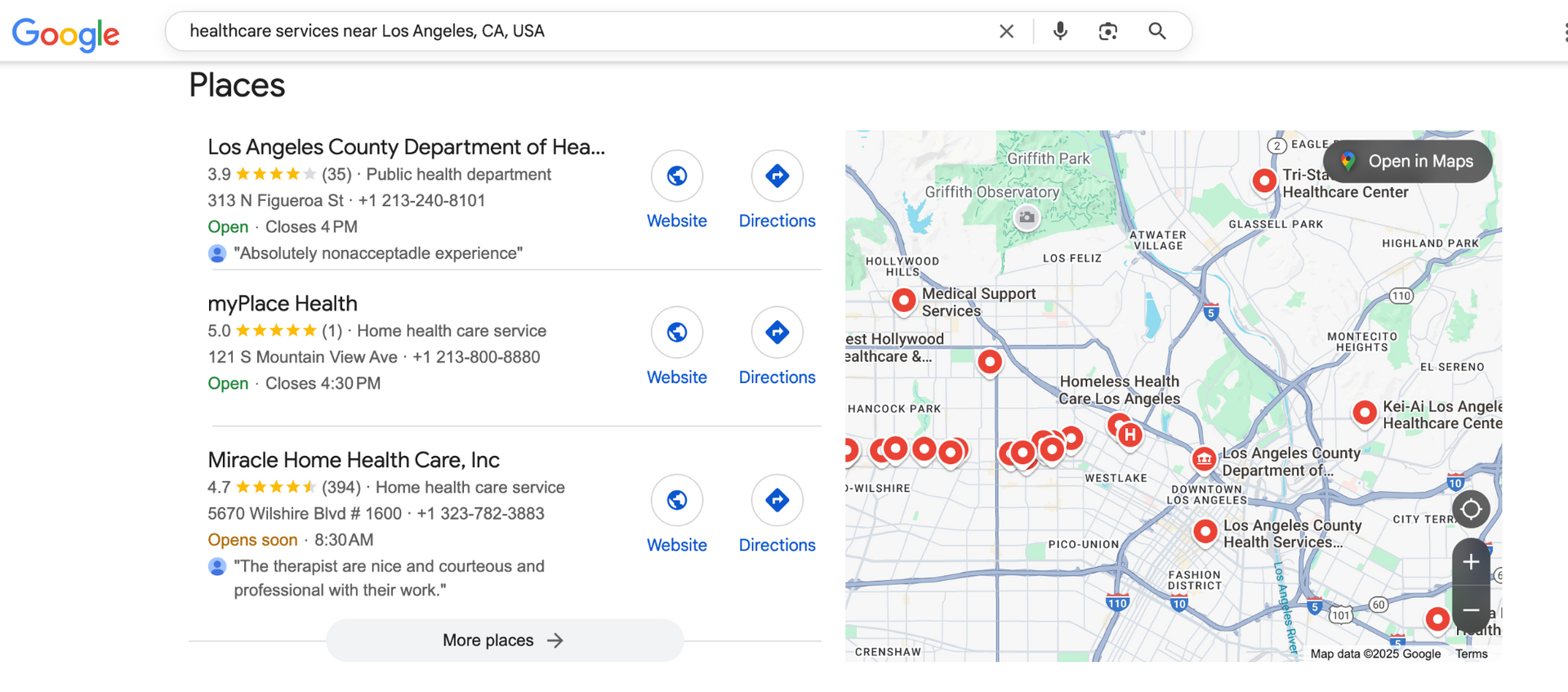10 Healthcare SEO Secrets That Pull in Valuable Patients Fast
When was the last time you opened a phone book to find a doctor? Today, when people need immediate medical attention or are researching healthcare providers, they go online.
In fact, 77% of patients start their healthcare journey through a search engine. That means your healthcare website isn’t just a business card; it’s your front door. And if it’s not optimized? You’re practically invisible.
That's where healthcare SEO comes in. A solid strategy isn’t just about ranking higher; it’s about making sure your practice shows up when patients are searching for healthcare providers.
In this guide to medical SEO, we’ll reveal 10 powerful strategies that can quickly boost your online visibility and help you attract the valuable patients your practice deserves.
1. Understanding Healthcare SEO: The Foundation
Healthcare SEO is the process of improving your healthcare website’s visibility on search engines like Google. But unlike general SEO strategies, healthcare SEO requires a higher level of precision, responsibility, and trust.
What Makes Healthcare SEO Different?
Healthcare SEO isn’t just about keywords and backlinks. It’s shaped by the high-stakes nature of medical information. Patients rely on your website to make potentially life-altering decisions. That’s why Google classifies medical content under YMYL (Your Money or Your Life) pages that can impact a person’s health, finances, or safety.
This means Google expects:
- Authoritativeness – Content written or reviewed by qualified professionals.
- Trustworthiness – Secure websites with accurate, verifiable content.
- Expertise – Demonstrated knowledge in the medical field, often through bios, credentials, or links to reputable organizations.
The Role of HIPAA and Patient Privacy
Any digital marketing strategy in the healthcare industry must comply with HIPAA (Health Insurance Portability and Accountability Act). That means:
- Avoiding the publication of personal health information in testimonials or reviews.
- Ensuring any contact forms or patient portals are secure and encrypted.
- Being cautious with retargeting ads or analytics tools that might inadvertently track sensitive user data.
Incorporating Medical SEO without HIPAA compliance can lead to serious legal consequences and damage your practice’s reputation.
Why Trust Signals Matter More Than Ever
When users search for medical services, they want to feel confident that your practice is safe and reliable. Strong healthcare SEO includes building trust signals such as:
- Real patient reviews
- Verified Google Business listings
- Secure (HTTPS) websites
- Updated contact info and medical credentials
These elements not only help SEO but also encourage patients to take the next step — booking an appointment.
Benefits of a Strong Healthcare SEO Foundation
With the right SEO foundation in place, your healthcare website becomes more than just a digital presence. It becomes:
- A Patient Magnet – Attract users who are actively looking for your services.
- A Reputation Booster – High-ranking content signals authority and builds trust.
- A Business Growth Engine – Convert online traffic into booked appointments and long-term patients.
Done right, healthcare SEO creates a sustainable system where your site attracts, informs, and converts even while you sleep.
2. Keyword Research: Targeting Patient Intent

Before you can attract patients, you need to know what they’re searching for. That’s where keyword research comes in. Think of it as eavesdropping on your ideal patients. What terms they type, what concerns they have, and what medical conditions they’re researching.
Start with tools like Google Keyword Planner or SEMrush. Look for long-tail keywords like “back pain chiropractor in Torrance” or “urgent care for kids open late.” These are intent-driven, location-specific keywords that pull in people ready to book.
Remember, context matters. Keywords like "pediatrician" are great, but "pediatrician accepting new patients in Torrance" is gold.
3. On-Page Optimization: Enhancing Website Content
Once you've identified your keywords, it’s time to sprinkle them smartly across your site. That means placing them in:
- Meta titles and descriptions
- Header tags (H1, H2, etc.)
- URL slugs
- Alt-text for images
But don’t overdo it. Keyword stuffing is a thing of the past. Today, search engines reward relevant content, logical structure, and smooth user experience. Use bullet points, short paragraphs, and internal links to guide the reader.
And don’t forget mobile responsiveness. Over 60% of healthcare searches happen on smartphones, so if your site isn’t mobile-friendly, you’re losing patients.
4. E-E-A-T Principles: Building Trust and Authority

In healthcare search engine optimization, trust is everything. Google uses E-E-A-T (Experience, Expertise, Authoritativeness, Trustworthiness) to evaluate your site. If you’re giving medical advice, it better come from someone with credentials.
Feature content authored or reviewed by licensed practitioners. Include bios and credentials. Back up claims with sources from recognized authorities like the CDC or Mayo Clinic.
Encourage patient testimonials and display affiliations with known organizations. These actions build trust not just with Google, but with your potential patients too.
5. Local SEO for Healthcare: Capturing the Nearby Audience

When people search for a doctor, clinic, or urgent care, they’re not looking across the country, they’re looking down the street. That’s why local SEO is crucial for medical practices.
Start With Your Google Business Profile
Your Google Business Profile (GBP) is the digital front door to your practice. Make sure it’s:
- Claimed and verified
- Complete with your Name, Address, and Phone Number (NAP) - and that these match exactly across your website, directories, and social media
- Loaded with high-quality photos of your office, staff, and waiting area
- Updated with hours, services, accepted insurance, and appointment links
The more complete and accurate your profile, the better you’ll show up in the Local Map Pack (those top local search results with star ratings).
Collect and Respond to Reviews
Online reviews aren’t just reputation builders, they directly impact your local ranking. Ask happy patients to leave honest reviews, especially right after a positive visit.
Pro Tip: Set up automated follow-ups through your patient portal or email system to gently remind patients to leave feedback.
And yes, respond to every review (even the not-so-great ones). A polite, professional reply shows you care and helps build trust with future patients.
Build Local Citations
A citation is any mention of your practice’s NAP across the web. These can appear on:
- Health directories (like Healthgrades, Zocdoc, Vitals)
- General business directories (Yelp, YellowPages, Bing Places)
- Local chambers of commerce or community websites
The more accurate and consistent your citations, the more trust Google has in your location data, which means better rankings.
Optimize for “Near Me” Searches
People often search using terms like:
- “dermatologist near me”
- “urgent care open now in Ventura”
- “walk-in clinic near me that takes Aetna”
Use these naturally in your page titles, meta descriptions, and homepage copy to help Google connect your site with local intent.
Bonus: Add Location Pages (If You Have Multiple Offices)
If you operate in more than one city or neighborhood, create a separate, optimized page for each location. This helps each office show up in its respective area and gives local patients the info they need fast.
6. Technical SEO for Healthcare: Ensuring Site Health

Let’s pop the hood on your website. No matter how sleek it looks on the outside, if the backend is messy, slow, or insecure, search engines will pass you by. That’s where technical SEO comes in. It is the foundation that supports everything else.
Speed Is Non-Negotiable
Patients don’t wait for slow websites and Google doesn’t either. Your site should load in under 3 seconds, especially on mobile. Use tools like:
- Google PageSpeed Insights
- GTmetrix
- WebPageTest
to identify what’s slowing you down. Compress large images, enable browser caching, and avoid clunky plugins that bog down performance.
Secure Your Site with HTTPS
If your site isn’t secure (i.e., doesn’t start with https://), that’s a red flag for both search engines and users. It’s a basic trust signal, especially crucial when you’re handling sensitive healthcare topics or appointment forms.
Make It Accessible to All
Accessibility isn’t just good practice; it’s good SEO. Make sure your site follows WCAG guidelines, including:
- Alt text for all images
- Clear keyboard navigation
- Logical header structure (H1, H2, H3...)
These not only help patients with disabilities but also make your site easier for search engines to crawl and index.
Use Structured Data (Schema Markup)
Structured data is like giving search engines a cheat sheet. Using schema.org, you can tag your content to specify things like:
- Medical services offered
- Business location and hours
- Doctors on staff
- FAQs or articles
This can help your site appear with rich snippets (those enhanced results with ratings, hours, and more) making your listings stand out.
Pro Tip: Use Google’s Rich Results Test to check if your markup is working correctly.
Mobile-Friendly Is a Must
With most searches now happening on phones, your website must be fully responsive. That means no pinching, zooming, or buttons too small to tap. Test it with Mobile-Friendly Test tool and adjust as needed.
A technically sound website builds trust with both search engines and patients. It ensures your content gets seen, your forms get filled out, and your practice keeps showing up where it matters.
7. Content Marketing For Healthcare: Educating and Engaging Patients

Content is the lifeblood of your SEO efforts. You need to consistently publish helpful, relevant, and accurate content.
Start a blog answering common questions or medical topics like “What are the signs of dehydration in kids?” or “How to manage chronic back pain.” Make content skimmable, engaging, and backed by evidence.
Use videos to explain procedures or introduce your staff. Build a content calendar to plan topics ahead and ensure consistency. When you educate, you build trust. And when patients trust you, they book.
8. Link Building: Establishing Online Authority
Links are like digital referrals. When a reputable site links to yours, Google sees that as a vote of confidence.
Focus on getting backlinks from:
- Healthcare directories
- Local news outlets
- Partner providers and organizations
Guest post on other blogs, collaborate with health influencers, or get featured in community events. But steer clear of shady, spammy links. One bad backlink can tank your rankings.
9. Analytics and Continuous Improvement

SEO isn’t something you set once and forget. It’s more like tending a garden. You plant the seeds, nurture them regularly, and keep watch for anything that might need attention. To stay visible online, it’s important to track your progress, test what’s working, and make ongoing improvements.
Measure What Matters
Start by using tools like Google Analytics 4 (GA4) and Google Search Console.
These platforms provide valuable insights, including:
Where your traffic originates (organic search, referrals, etc.)
- Which pages are attracting the most visits
- What keywords are leading users to your site
- How visitors are interacting with your content (time spent, bounce rate, conversions)
These insights go beyond surface-level data and can help you understand what’s truly resonating with your audience. For example, if you notice that a particular service page has a high bounce rate, it could signal that the content isn’t meeting visitors' needs.
Run A/B Tests to Fine-Tune Results
If you’re unsure whether a headline, call-to-action (CTA), or page design is effective, testing can give you clear answers.
You can use tools like VWO, or Optimizely to run A/B tests that compare different versions of:
- Appointment buttons (such as “Book Now” versus “Schedule a Visit”)
- Service page headlines
- Landing page layouts
These small tweaks can lead to noticeable improvements in user engagement and conversion rates.
Look Beyond Rankings
Tracking your keyword rankings is helpful, but don’t focus solely on where you appear in search results. The more important goal is attracting the right audience—patients who are ready to take the next step.
Pro Tip: Use GA4 to set up conversion goals such as appointment requests or click-to-call actions. These give you a better sense of how well your healthcare seo strategy efforts are turning visits into real outcomes.
Keep Content Fresh
search engine results page favor content that is current and relevant. Revisit your top-performing blogs and service pages regularly.
Make sure to:
- Update outdated statistics and links
- Add new FAQs based on common patient questions
- Improve formatting and internal links for easier reading
Even small updates can help improve your rankings and show patients that your information is up to date.
SEO works best when it’s treated as an ongoing process. With regular analysis, testing, and updates, your website will remain competitive and continue to attract valuable traffic over time.
10. Leveraging EDNA360: A Holistic Approach
At EDNA Digital Marketing, we don’t just do SEO; we implement the EDNA360 Marketing System, which combines local SEO, paid ads, email automation, content marketing, and more into one seamless strategy.
We create a customized healthcare SEO strategy that will help you reach your company’s specific goals. Whether you're a solo practice or a large healthcare organization, we craft digital marketing strategies that help healthcare providers grow their patient base without working longer hours.
We’ve helped dozens of healthcare practices dominate their markets. Why not yours?
FAQs
1. How long does it take to see results from healthcare SEO?
Expect to see measurable results in 3 - 6 months. It’s a long game with high ROI.
2. Is it necessary to have a blog on my healthcare website?
Yes. Blogs help provide fresh content, improve SEO, and answer patient questions.
3. Can I manage healthcare SEO on my own, or should I hire professionals?
You can try the basics, but healthcare SEO requires time, expertise, and constant updates. Hiring experts can save you both time and money.
4. How does local healthcare SEO differ from general SEO?
Local SEO focuses on geo-targeted search queries and business profile optimization which is crucial for medical practices serving a specific area.
Conclusion
Healthcare SEO is no longer optional. It is a vital part of growing any modern medical practice. From keyword research and on-page optimization to local SEO and E-E-A-T compliance, every strategy we’ve covered plays a role in helping you attract new patients quickly.
Your competitors are already investing in healthcare digital marketing. Now is the time to take action and stay ahead.
If you're ready to grow your healthcare business, contact EDNA Digital Marketing. Let’s create a strategy that delivers real, measurable results.










